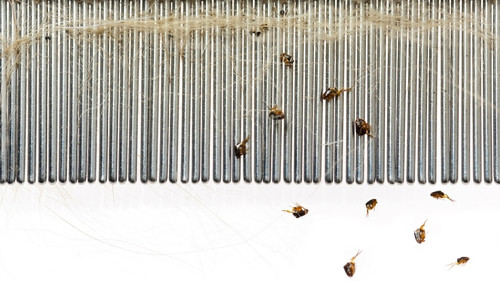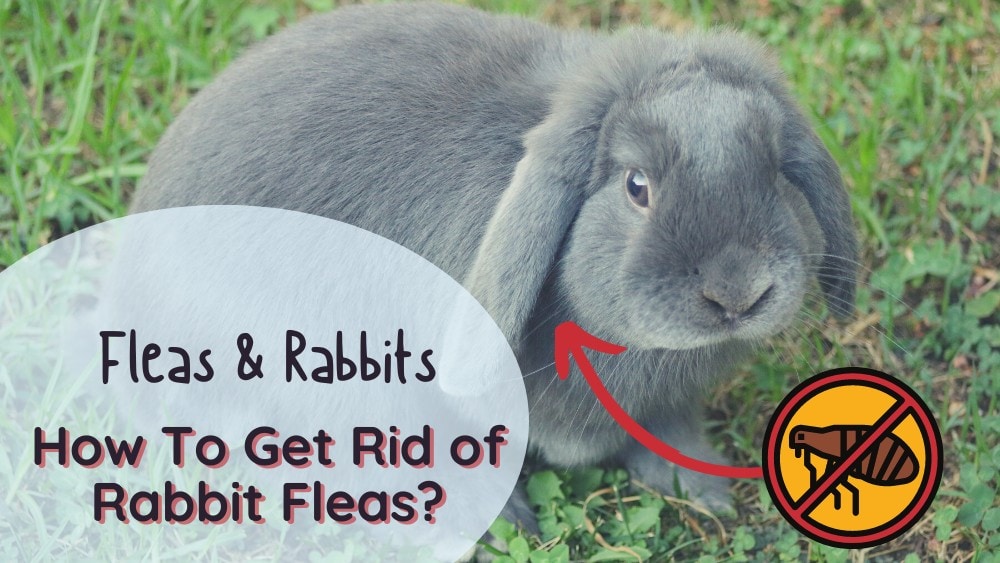One day you notice that your cute bunnies are all itchy and losing fur. A closer look reveals tiny bite marks on their skin and tiny dark or brown specks of dirt on the rabbit’s fur. A google search later, and your fears are confirmed.
Yes, as dreadful as it is, your rabbits may indeed have fleas. You have heard of fleas on cats and dogs, which might surprise you, but rabbits can also get fleas. Naturally, you’ll want to know what rabbit fleas look like and how to rid the rabbits’ fur of fleas – and how your pet became infested with those pesky little devils in the first place.
In this article, we’ll lead you through how to treat fleas on rabbits. We’ll cover the following:
- The materials you need to prepare
- The signs that your rabbit has fleas
- Step-by-step instructions on how to get rid of your rabbit’s fleas
Saddle up!
Can Rabbits Get Fleas?
Yes, pet rabbits can contract fleas, whether they live outdoors or in the house. We’re used to fleas on family pets like cats and dogs, but it might come as a surprise when they infest our bunnies. They can get fleas from wild rabbits or other animals outdoors, or from other pets in an indoor environment.
How to Get Rid of Fleas on Rabbits
To get rid of fleas on rabbits, be sure that your rabbits actually have fleas. Use a flea comb to find fleas or flea dirt. Then purchase the correct topical medications, apply them to your pet rabbits, and clean up their environment to ensure the fleas don’t come straight back.
I’d recommend using veterinary-approved spot-on products, as these are the safest and most effective. If you aren’t certain of the diagnosis, see a veterinarian immediately, as there are other skin conditions that can have similar symptoms.
What You Will Need to Follow this Tutorial
Before you start the step-by-step tutorial to rid fleas from your rabbit’s life, you’ll need to do some preparation, including sourcing some equipment and rabbit-specific flea treatments.
Flea Comb

These fine-toothed combs help catch fleas and flea eggs, reducing the flea population. They, however, do so little in combating a severe flea infestation. A flea comb might relieve your rabbit and reduce their misery so they are not bitten all day.
However, some rabbits are highly sensitive to grooming and find the process stressful. If that’s the case, we recommend not using a flea comb on your rabbit.
Topical Medication
I recommend three topical treatments for rabbit fleas: Advantage, Revolution, and Xeno. You can get all of them from your veterinary clinic, or online using a vet’s prescription.
Advantage contains imidacloprid. There isn’t a rabbit-specific version, so you’ll need to use one that’s marketed for cats. Your vet will be able to advise you on the right size for your rabbit, as they don’t fit into the same weight categories as cats. For rabbits under the age of 8 weeks and elderly rabbits, Advantage should be avoided.
Another flea treatment that is safe to use is Revolution (Stronghold for those in the UK). It is the same drug used to treat and prevent pests like mites and ticks. Your vet would normally recommend Revolution when your rabbit has proven sensitive to Advantage. While Revolution is effective, it won’t keep your rabbits free of fleas for as long as Advantage does.
Xeno 450, a topical medication containing ivermectin, is also a good choice since it kills both endo and ectoparasites like lice, mites, and fleas. It’s safe for use on ferrets, guinea pigs, and rabbits, and I highly recommend it. You can even use it as a monthly preventative, as you would with a dog or cat’s flea medicine.
A Note on Licensed Meds
In all species, but especially rabbits, you may hear the term “off-licence medication”. This means that the company that makes the treatment hasn’t undergone extensive safety tests to pass the government’s medical authorization process for this treatment in this species.
Does that mean the medications don’t work? Not necessarily. As people often don’t want to spend a lot of money on rabbit medicines, the manufacturers often don’t want to make the investment of getting authorized. Does it mean the medicines are safe? Well, that’s hard to say, as there isn’t a lot of data. Your rabbit might be fine, or they might have an unexpected reaction.
I always recommend you choose a licensed medication for your rabbits if one is available, as you’ll then know that the drug has been tested thoroughly and will be safe and effective for the condition you’re treating.
Beware: Unsafe or Ineffective Flea Treatments for Rabbits
When treating fleas in rabbits, there are a couple of options that I don’t recommend:
- Flea collars – Flea collars aren’t a good idea for rabbits. They may start chewing on it, the flea collar may release too much product and it may cause discomfort to the pet rabbits.
- Flea powders – Natural flea powders are almost totally ineffective and not recommended to treat or prevent fleas on a pet rabbit.
Step-by-Step Instructions
Now that you’ve prepared your materials, here is the five-step process to treating fleas on rabbits.
Step One: Make sure it’s fleas
Rabbits can get a variety of skin conditions, and fleas aren’t always to blame. If you’re at all unsure, it’s best to take your rabbit to the local vet for a check-up, so that they get the right treatment straight away.
If your rabbit has fleas, you might see one of the following:
- Flea Bites
Fleas leave itchy bites, and sometimes you can see these on your rabbit’s skin. Part your rabbit’s coat gently and check for red marks like tiny mosquito bites. - Fur loss and scaling
As your rabbits scratch their skin, you may see fur loss and scaling of the skin. However, excessive scratching and flaky skin could also be a sign of other conditions like Cheyletiella (also sometimes called walking dandruff) or ringworm. It’s best to consult your vet if you notice this symptom, to get the correct diagnosis - Flea Dirt
Check for dark or brown specks of dirt on your rabbits’ skin. To be sure it’s flea poop or flea dirt, place a speck on a paper towel and place a drop of water on it. If it is flea poo, a red ring (blood) will appear around the speck after a few minutes.
Here’s a flea-dirt test in action:
- Anemia
Fleas feast on blood, so large numbers of fleas could leave your rabbits anemic. You might notice they seem weak with pale gums. It’s important to check with a vet if you think your rabbit might be anemic. - Live Fleas
To check for this last clue, you’ll first need to know what rabbit fleas look like. Rabbit fleas are larger than cat and dog fleas – although rabbits can be infested with either the rabbit variety or the regular cat and dog type. Because rabbits have very thick fur, it’s difficult to see live fleas, but sometimes you can spot them feeding on the rabbit’s ears.
Step Two: Remove any visible fleas
You can use flea combs to remove any visible fleas from your household pets.
- Prepare a bucket of soapy water.
- Keep the bunny in a comfortable position and start combing through its fur to catch fleas, their eggs, and poop.
- Rinse the flea comb in soapy water to kill flea eggs and the live fleas you remove.
- Repeat this process twice a day for a week and check if things are any better. If the situation is still bad, you will have to also use one of the safe flea treatments for rabbits.
Removing all the fleas with a comb might be impossible. You can, however, remove just enough captured fleas to keep the bunny comfortable.
Step Three: Apply vet-approved topical treatment.
Now comes the time to apply the Advantage, Revolution, or Xeno that you prepared. If you’re dealing with more than one rabbit, double-check at this stage that you’ve picked up the right dose for the right rabbit.
You apply a rabbit spot-on in the same way as you would for another species. Part the hair at the back or neck, and empty the tube completely. You can see a demonstration of the technique here:
Don’t touch the area, and don’t let other animals lick it. You shouldn’t give the rabbits a flea bath or use flea dips.
Step Four: Look at the environment.
If you really intend to eradicate the flea challenge from your bunnies, you’ll have to thoroughly clean the surrounding environment since rabbit fleas mostly stay in the environment. This includes carpets and furniture and also the rabbits’ enclosure.
First, wash everything you can – bedding, towels, blankets, curtains, both your own and the rabbits’. You should also vacuum the entire house daily, paying close attention to corners and hidden, underneath parts with little foot traffic.
You should also use insect sprays, carpet treatments, and boric acid for surfaces to ensure you avoid reinfestation of fleas. However, make sure to remove your bunnies and other pets while the sprays and treatments are active. The duration is usually indicated on the tin, so be sure to check.
Afterward, wear white socks to check if there are any fleas you didn’t get rid of. The logic behind this is that adult fleas are attracted to light colors, so they’ll get attracted to your socks as you walk in the house.
Cleaning your space and the rabbits alone is not enough. You want to ensure that all your household pets are up-to-date with their flea control. That way, if any more fleas try to infest your home, they won’t have a good food source.
The area outside your house should also be cleaned properly since the pets might play outdoors and come back with fleas making the whole problem cyclic. You can also use food-grade diatomaceous earth outdoors as it deters fleas and keeps ear mites and fur mites away.
Step Five: Mark it on your calendar.
Find out how regularly you need to apply the vet-approved medication on your pet, and be sure to mark it on your calendar so you don’t forget to give the next dose. Most spot-ons can be administered once a month. It’s most effective to do all pets at the same time.
Conclusion
Although rabbit fleas might not be something you’d thought about before, they can be challenging to identify and treat. Using our step-by-step guide, you can start getting the problem under control. Always remember to use vet-approved products to treat rabbit fleas, to keep your rabbit as safe as possible.
If you’ve enjoyed this guide, please let us know in the comments below, and share it with any of your friends who have outdoor rabbits, indoor rabbits, or house rabbits!


